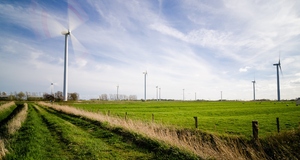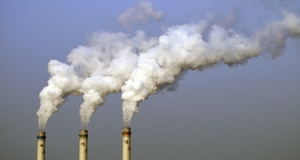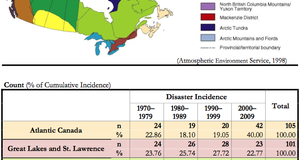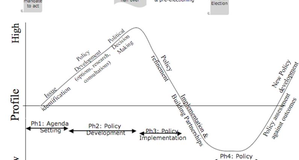The Inequalities of Climate Change and Poverty: Impact Analysis and Potential SolutionsV. AsiaWhile climate change is clearly a global problem requiring global solutions, it can be useful to focus on specific regions in order to form a better assessment of concrete actions that can be taken to mitigate climate change at a regional or local level. Asia is a key area of interest for climate change researchers and policymakers due to its recent industrialization and growth in conjunction with its geographic location making it especially at risk from global climate change (28). As previously addressed, data from the World Bank shows that the uneven progress in global poverty decline has significant regional components (23). Asia is a key player in international climate change negotiations and has played a critical role in the COP meetings over the past twenty years. At COP15 in Copenhagen, Asian countries, and China in particular, were largely blamed for the failure to reach a significant treaty. Through a series of backroom deals, conducted away from the media spotlight, China purposefully undermined the negotiations. For example, it was China’s representative who insisted on removing the industrialized country targets, previously set as an 80% cut by 2050. Collaborating at times with India (another developing Asian country), China successfully removed most of the binding language of the agreement, including a 2020 peaking year in global emissions and a long-term target of 50% emissions cuts by 2050. By doing so, China, with an economy strongly dependent on cheap coal at the time, was able to negotiate a deal that did not limit their economic growth while simultaneously placing the blame on the United States. This is not to say that climate change was not an issue for China at the time. Rather, they recognized the issue, but instead chose to prioritize their own growth into an international superpower (with significant negotiating power) (29). Since 2009, and in part as a result of their actions at Copenhagen, climate change has become a much more serious issue for Asian countries. In recent years, China, India, Japan, and Korea have consistently ranked in the top ten countries for carbon dioxide emissions per capita, with China recently surpassing the United States. At the same time, these countries began to feel effects of these increased emissions. In China, rampant air pollution has forced city shutdowns as air pollution contributed to more than 670,000 deaths in 2012. In the Philippines, Typhoon Haiyan in 2013 offered a preview of the increase in natural disasters that the highly vulnerable country can expect as a result of climate change (30).On a more optimistic note, the primary concern of Asian countries in 2009, that cutting emissions was synonymous with cutting their growth potential, no longer holds true. India has rapidly expanded its use of solar and China is leading the world in employing renewable energy technologies. Peaking emissions is no longer a burden, but rather an opportunity, particularly for businesses, to ensure greater energy security, affordable supplies, and recognized leadership internationally (30). At COP21, the Philippines took on a new leadership role as a large Asian developing nation. As the chair of the Climate Vulnerable Forum, a coalition of 43 countries pushing for the inclusion of the 1.5 ˚C goal as opposed to the 2 ˚C. The Philippines were also critical in advocating for language of loss and damages to assist countries unable to adapt to climate change. Thanks to their leadership, the Climate Vulnerable Forum, and in particular the Small Island Developing States (SIDS) of the Pacific Ocean, played a much more prominent role at COP21 than at any previous meetings (30). VI. Case Study: BangladeshWhile much attention was focused on Asia’s emerging world leaders China and India, smaller Asian countries still made their voices heard, both in the negotiations and in other venues at COP21. A prime example of this was Bangladesh, the country that in 2015 was ranked as the most vulnerable country to climate change in Maplecroft’s Climate Change Vulnerability Index (24). As a country that is already facing the negative effects of climate change and consequently been forced to make significant changes, Bangladesh offers a unique perspective on techniques of adaptation. Representing Bangladesh, Dr. Saleemul Huq spoke at COP21 about the best practices his country has adopted as they adapt to climate change. A significant problem that Bangladesh faces as a coastal country is changes in sea level, which has led to other problems such as soil salinity, river siltation, and erosion. Because Bangladesh is primarily an agricultural based society, these ecological changes have significant social ramifications. These include an increased vulnerability to natural disasters, migration, and changes in land use. For example, because of the increased soil and water salinity in regions where people used to grow rice, farmers have been forced to switch to more saline-resistant strains. In addition, in order to offset some of their losses and make the best of the situation, some farmers now cultivate rice-shrimp in the same areas as rice, allowing for another source of food and income. Bangladesh also represents a unique approach to adaptation that emphasizes equitable visions of development and the possibility of rural futures. While a largely agricultural country, its capital city, Dhaka, ranks among the top 20 cities globally in exposure to extreme climate. Most residents in the region have migrated to the city and are economically poor, working in unskilled labor positions. As a result of rising land and housing prices, this group, making up almost 30-40 percent of the population, has been forced into squatter settlements. In these high-density settlements, 91 percent of structures are comprised of corrugated iron (CI) sheets, which gain and radiate more heat than other building materials. These high heat gaining and emitting materials, allowing little airflow for ventilation, exacerbate the expose of residents to the significant direct and indirect impact of temperature variability (16). This example demonstrates how the urban development of high-density housing as a result of economic poverty creates conditions that can exacerbate the hazardous effects of climate change. In their analysis of this region, Jabeen and Guy emphasize the need for “fluidity,” implying flexibility towards a variety of technological solutions for local challenges. Sustainable development must rely of alternative pathways rather than fixed ones (16). As Dr. Huq emphasized at COP21, adaptation to climate change is a “normative” process. The adaptation or mitigation strategies being used in Bangladesh are unlikely to work in other communities around the world. In spite of the way that decisions are made, at large international meeting such as the COPs, changes are implemented at a very local level and must therefore be specifically tailored to the needs and resources of those communities. VII. Adaptation and MitigationThe extent to which climate change will impact poverty, both throughout Asia and across the world, is directly tied to the ability of populations to both adapt to and mitigate its effects. There are several factors that can impact the ability of a society to successfully adapt. These include autonomous adaptation, such as the ability to freely migrate or switch occupations, policy-induced adaptation, typically through government action, the distribution of resources, such as land and labor, and rural households as consumers and producers of food (18). The primary mechanism by which the UNFCCC has proposed to support climate change adaptation and mitigation projects is through the Green Climate Fund, first established at COP15 in 2009. The Green Climate Fund is one mechanism by which the global goal of raising $100 billion by 2020 is to be met. As of April 2016, 43 governments had contributed $10.3 billion (31). Another mitigation program under the UNFCCC is REDD+, reducing emissions from deforestation and forest degradation, which aims to reduce carbon emissions through enhancing forest management in developing countries. This program was founded on the basis that deforestation and forest degradation account for approximately 20 percent of annual total greenhouse gas emissions worldwide and the vast majority of this deforestation takes place in developing countries. REDD+ is a vehicle by which the UNFCCC rewards developing countries for their efforts to reduce emissions through forest management. While there are very few specific guidelines, allowing for flexibility at the individual country level, REDD+ highlights five “eligible activities” that developing countries may use to reduce emissions and remove greenhouse gases. These include reducing emissions from deforestation, reducing emissions from forest degradation, conserving forest carbon stocks, the sustainable management of forests, and enhancement of forest carbon stocks (32). While REDD+ has seen some success, it has been criticized for a lack of transparency, particularly regarding the use of funds in developing countries. Cases of corruption and mismanagement undermining the implementation of REDD+ have arisen in countries such as Cambodia, Papua New Guinea, Liberia, and others (32). In Nepal, an analysis of REDD+’s impact found some benefits, including better control over forest fires, decrease in extraction of grass, fodder, fuel wood and timber, and an enhanced participation of community members such as women and poor people. However, these forest management meetings also had a negative impact on local groups, adding additional working hours and forcing many to cut down on the quality of fuel wood or fodder grass they normally used to maximize carbon credits. Because REDD+ focuses only on the reduction of emissions, it can at times, as shown in Nepal, conflict with poverty reduction strategies. In the case of Nepal, deforestation and forest degradation stemmed primarily from the livelihood needs of the local community. Therefore, this study found REDD+ programs must also be more comprehensive, taking into account the lives of populations who depend on forests (33). At COP21, while the focus of negotiations remained primarily on financial mechanisms for adaptation and mitigation, the meeting also served as an avenue for the exchange of skills and ideas between governments, NGOs, and other interest groups. During a panel hosted by the U.S. State Department, city leaders from around the world, including Copenhagen, Denmark and U.S. cities Oakland, California, and Kotzebue, Alaska, shared their experience and best practices for adaptation and mitigation strategies at the city level. It is especially significant as 50 percent of the world population currently lives in cities, and this is expected to rise to 67 percent by 2100. In addition, cities are an ideal testing ground for new practices and adaptation strategies. As highlighted by panelist Maija Lukin, a councilwoman in Kotzebue, cities and local leaders can’t always wait for funding or direction from the international or even national level to combat climate change. In the case Kotzebue, a small coastal city with a population of just over 3000, coastal erosion, diminishing sea ice, and a lack of food security all prompted immediate local action. After petitioning for support from the state and national government, the community secured funding for the Shore Avenue Project, which made significant improvements to mitigate coastal erosion and prevented the city from being swallowed by the ocean. It is important to note that this is just one, very unique situation, but it represents the variety of strategies to combat climate change taking place in communities around the world. As each community faces their own challenges, international and national policy must support local initiatives by allowing as much flexibility as possible.Continued on Next Page » Suggested Reading from Inquiries Journal
Inquiries Journal provides undergraduate and graduate students around the world a platform for the wide dissemination of academic work over a range of core disciplines. Representing the work of students from hundreds of institutions around the globe, Inquiries Journal's large database of academic articles is completely free. Learn more | Blog | Submit Latest in Environmental Studies |


















